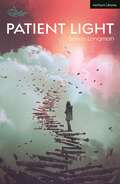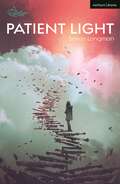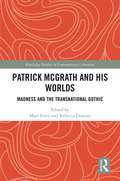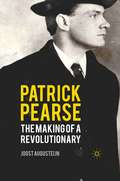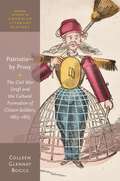- Table View
- List View
Pathways to Language: From Fetus to Adolescent (The Developing Child #38)
by Annette Karmiloff-Smith Kyra KarmiloffOur journey to language begins before birth, as babies in the womb hear clearly enough to distinguish their mother's voice. Canvassing a broad span of experimental and theoretical approaches, this book introduces new ways of looking at language development. A remarkable mother-daughter collaboration, Pathways to Language balances the respected views of a well-known scholar with the fresh perspective of a younger colleague prepared to challenge current popular positions in these debates. The result is an unusually subtle, even-handed, and comprehensive overview of the theory and practice of language acquisition, from fetal speech processing to the development of child grammar to the sophisticated linguistic accomplishments of adolescence, such as engaging in conversation and telling a story. With examples from the real world as well as from the psychology laboratory, Kyra Karmiloff and Annette Karmiloff-Smith look in detail at the way language users appropriate words and grammar. They present in-depth evaluations of different theories of language acquisition. They show how adolescent usage has changed the meaning of certain phrases, and how modern living has led to alterations in the lexicon. They also consider the phenomenon of atypical language development, as well as theoretical issues of nativism and empiricism and the specificity of human language. Their nuanced and open-minded approach allows readers to survey the complexity and breadth of the fascinating pathways to language acquisition.
Pathways to Literacy, Year 4, Stage 5, Set B: Baboushka (PDF)
by Moira AndrewChristmas is such a busy time! Cleaning, cooking, making, mending... Those were the things that kept Baboushka busy. So she missed her chance to travel with the wise men. Then she found a way to bring Christmas love to everyone. A traditional tale of warmth and wisdom.
Pathways to Public Relations: Histories of Practice and Profession (Routledge New Directions in PR & Communication Research)
by Burton St. John Margot Opdycke Lamme Jacquie L’EtangOver the centuries, scholars have studied how individuals, institutions and groups have used various rhetorical stances to persuade others to pay attention to, believe in, and adopt a course of action. The emergence of public relations as an identifiable and discrete occupation in the early 20th century led scholars to describe this new iteration of persuasion as a unique, more systematized, and technical form of wielding influence, resulting in an overemphasis on practice, frequently couched within an American historical context. This volume responds to such approaches by expanding the framework for understanding public relations history, investigating broad, conceptual questions concerning the ways in which public relations rose as a practice and a field within different cultures and countries at different times in history. With its unique cultural and contextual emphasis, Pathways to Public Relations shifts the paradigm of public relations history away from traditional methodologies and assumptions, and provides a new and unique entry point into this complicated arena.
Pathways to Public Relations: Histories of Practice and Profession (Routledge New Directions in PR & Communication Research)
by Burton St. John III Margot Opdycke Lamme Jacquie L'EtangOver the centuries, scholars have studied how individuals, institutions and groups have used various rhetorical stances to persuade others to pay attention to, believe in, and adopt a course of action. The emergence of public relations as an identifiable and discrete occupation in the early 20th century led scholars to describe this new iteration of persuasion as a unique, more systematized, and technical form of wielding influence, resulting in an overemphasis on practice, frequently couched within an American historical context. This volume responds to such approaches by expanding the framework for understanding public relations history, investigating broad, conceptual questions concerning the ways in which public relations rose as a practice and a field within different cultures and countries at different times in history. With its unique cultural and contextual emphasis, Pathways to Public Relations shifts the paradigm of public relations history away from traditional methodologies and assumptions, and provides a new and unique entry point into this complicated arena.
The Patient Gloria (Oberon Modern Plays)
by Gina MoxleyInspired by the 1965 films Three Approaches To Psychotherapy (The Gloria films), The Patient Gloria is a provocative meditation on therapy and female desire. In a political context where misogyny is the winning ticket, Gina Moxley re-examines the canon of psychotherapy with an upfront mash-up of re-enactment, lived experience and feminist punk gig. It's an experimental extravaganza. And it's therapeutic. It's very therapeutic.
Patient Light (Modern Plays)
by Simon LongmanWe just wait. Old light. And new light. We just wait. For each other, patiently wait.Patient Light follows a day in the life of a young person in Peterborough and how their vision of the future is blinded by carrying the weight of the world on their shoulders. It concerns the everyday, mundane things that we carry in our head and rarely, if ever, say out loud. Presented as a stream of consciousness, the play examines our need for aspiration, and how to use the world's frustrations to your advantage. This edition was published to coincide with the production by Eastern Angels in October 2021.
Patient Light (Modern Plays)
by Simon LongmanWe just wait. Old light. And new light. We just wait. For each other, patiently wait.Patient Light follows a day in the life of a young person in Peterborough and how their vision of the future is blinded by carrying the weight of the world on their shoulders. It concerns the everyday, mundane things that we carry in our head and rarely, if ever, say out loud. Presented as a stream of consciousness, the play examines our need for aspiration, and how to use the world's frustrations to your advantage. This edition was published to coincide with the production by Eastern Angels in October 2021.
Patients Making Meaning: Theorizing Sources of Information and Forms of Support in Women’s Health (Routledge Studies in Rhetoric and Communication)
by Bryna Siegel Finer Cathryn Molloy Jamie White-FarnhamThis book explores how women make meaning at various health flashpoints in their lives, overcoming fear, anxiety, and anger to draw upon self-advocacy, research, and crucial decision-making. Combining focus group research, content analysis, autoethnography, and textual inquiry, the book argues that the making and remaking of what we call “patient epistemologies” is a continual process wherein a health flashpoint—sometimes a new diagnosis, sometimes a reoccurrence or worsening of an existing condition or the progression of a natural process—can cause an individual to be thrust into a discourse community that was not of their own choosing. This study will interest students and scholars of health communication, rhetoric of health and medicine, women’s studies, public health, healthcare policy, philosophy of medicine, medical sociology, and medical humanities.
Patients Making Meaning: Theorizing Sources of Information and Forms of Support in Women’s Health (Routledge Studies in Rhetoric and Communication)
by Bryna Siegel Finer Cathryn Molloy Jamie White-FarnhamThis book explores how women make meaning at various health flashpoints in their lives, overcoming fear, anxiety, and anger to draw upon self-advocacy, research, and crucial decision-making. Combining focus group research, content analysis, autoethnography, and textual inquiry, the book argues that the making and remaking of what we call “patient epistemologies” is a continual process wherein a health flashpoint—sometimes a new diagnosis, sometimes a reoccurrence or worsening of an existing condition or the progression of a natural process—can cause an individual to be thrust into a discourse community that was not of their own choosing. This study will interest students and scholars of health communication, rhetoric of health and medicine, women’s studies, public health, healthcare policy, philosophy of medicine, medical sociology, and medical humanities.
Patriarchy’s Creative Resilience: Late Victorian Speculative Fiction (Among the Victorians and Modernists)
by Michael KrampPatriarchy’s Creative Resilience explores the disturbing sustainability of White male supremacy. Kramp traces an imaginative failure and an imaginative success; his focus on British speculative fiction published between 1870 and 1900 demonstrates how even this elastic and wildly inventive literary form remains incapable of promoting non- patriarchal masculinity, and he attributes this inability to the creative resiliency of white male supremacy. He demonstrates the inventive use of diverse resources that we frequently view as custom or uncomplicated history and a versatility that we often dismiss as sheer power. He draws on an archive of late nineteenth- century speculative fiction to detail a versatile patriarchal toolbox, including hegemonic masculinity, control of dangerous women, hyperbolic and sentimental performances of male sovereignty, and reversions to authoritarian, at times violent conduct. He also considers how the classic military strategy of dividing to conquer undergirds all these tactics, inhibiting our creating energies and dynamic collaborations. Various chapters demonstrate the enterprise, ingenuity, and adaptability of patriarchy to refashion and rejustify normalized systems of oppression. While scholars have consistently identified moments and agents of resistance to patriarchal structures by highlighting creativity, resiliency, and resourcefulness, Kramp’s project reveals how patriarchy itself is creative, resilient, and resourceful.
Patriarchy’s Creative Resilience: Late Victorian Speculative Fiction (Among the Victorians and Modernists)
by Michael KrampPatriarchy’s Creative Resilience explores the disturbing sustainability of White male supremacy. Kramp traces an imaginative failure and an imaginative success; his focus on British speculative fiction published between 1870 and 1900 demonstrates how even this elastic and wildly inventive literary form remains incapable of promoting non- patriarchal masculinity, and he attributes this inability to the creative resiliency of white male supremacy. He demonstrates the inventive use of diverse resources that we frequently view as custom or uncomplicated history and a versatility that we often dismiss as sheer power. He draws on an archive of late nineteenth- century speculative fiction to detail a versatile patriarchal toolbox, including hegemonic masculinity, control of dangerous women, hyperbolic and sentimental performances of male sovereignty, and reversions to authoritarian, at times violent conduct. He also considers how the classic military strategy of dividing to conquer undergirds all these tactics, inhibiting our creating energies and dynamic collaborations. Various chapters demonstrate the enterprise, ingenuity, and adaptability of patriarchy to refashion and rejustify normalized systems of oppression. While scholars have consistently identified moments and agents of resistance to patriarchal structures by highlighting creativity, resiliency, and resourcefulness, Kramp’s project reveals how patriarchy itself is creative, resilient, and resourceful.
Patricia Highsmith on Screen (Palgrave Studies in Adaptation and Visual Culture)
by Wieland Schwanebeck Douglas McFarlandThis book is the first full-length study to focus on the various film adaptations of Patricia Highsmith’s novels, which have been a popular source for adaptation since Alfred Hitchcock’s Strangers on a Train (1952). The collection of essays examines films such as The Talented Mr. Ripley, The Two Faces of January, and Carol, includes interviews with Highsmith adaptors and provides a comprehensive filmography of all existing Highsmith adaptations. Particular attention is paid to queer subtexts, mythological underpinnings, philosophical questioning, contrasting media environments and formal conventions in diverse generic contexts. Produced over the space of seventy years, these adaptations reflect broad cultural and material shifts in film production and critical approaches to film studies. The book is thus not only of interest to Highsmith admirers but to anyone interested in adaptation and transatlantic film history.
Patrick Chamoiseau: Recovering Memory (Contemporary French and Francophone Cultures #8)
by Maeve McCuskerThis timely new book skilfully examines the work of the award-winning writer Patrick Chamoiseau. Considered by many as one of the most innovative writers to hit the French literary scene in over 40 years, Chamoiseau made his name with his book Texaco (published in 1992 and winner of the highest literary prize in France, the Prix Goncourt). His books have gone on to sell millions and his work has been translated by a number of academic presses. McCusker sets the author in context, providing a valuable contribution to ‘memory studies’ by looking at literary representation of memory in Martinique, a society founded on slavery but now politically assimilated to the metropolitan centre, France.
Patrick Kavanagh, A Biography: The Acclaimed Biography of One of the Foremost Irish Poets of the 20th Century
by Dr Antoinette QuinnAntoinette Quinn's acclaimed biography of Patrick Kavanagh, the most important Irish poet between the death of W.B. Yeats and the rise of Seamus Heaney, tells the triumphant story of his journey from homespun balladry through early journal and poetry publications to his eventual coronation as one of the most influential figures in Irish poetry.Kavanagh (1904–1967) was born in County Monaghan, the son of a cobbler-cum-small farmer. He left school at thirteen to work the land but continued to educate himself, reading and writing poetry in his spare time. In 1929 he began contributing verses to the Irish Statesman and was soon publishing in Irish and English journals. His first collection, Ploughman and Other Poems, appeared in 1936 and was followed by an autobiography, The Green Fool, in 1938. In 1939 he moved to Dublin where he spent the rest of his life as a freelance writer and as part of the social and literary scene, keeping company with a gifted generation of writers, among them Flann O’Brien and Brendan Behan. He gained recognition as an important literary voice with his long poem ‘The Great Hunger’ in 1942. Further collections and the novel Tarry Flynn appeared in the following decades to growing critical acclaim. Published to widespread praise, Patrick Kavanagh, A Biography traces Kavanagh's publishing history as well as revealing what he was writing in the long interval between his books. This engaging, well-researched account of his daily professional life as a writer, his revisions and redraftings, his negotiations with publishers and editors, dispels the view that he was an untutored, gormless genius visited by an occasional flash of inspiration.Patrick Kavanagh, A Biography is the definitive account of Patrick Kavanagh’s life and work and should be the standard for years to come.Patrick Kavanagh, A Biography: Table of ContentsIntroductionNo Genealogic Rosary (1850–1910)Childhood (1904–1918)Serving his Time (1918–1927)Dabbling in Verse (1916–1930)Farmer-Poet (1929–1936)Towards The Green Fool (1936–1937)The Green Fool and its Aftermath (1937–1939)I Had a Future (1939–1941)Bell-lettres (1940–1942)The Great Hunger (1941–1942)Pilgrim Poet (1940–1942)Marriage and Money? (1942–1944)The Enchanted Way (1944–1947)Film Critic (1946–1949)Tarry Flynn (1947–1949)From Ballyrush to Baggot Street (1948–1951)King of the Kids (1949–1951)Bluster and Beggary (1952–1953)Trial and Error (1954)The Cut Worm (1954–1955)The American Dream (1955–1957)Noo Pomes (1957–1958)Come Dance with Kitty Stobling (1959–1960)Roots of Love (1960–1964)Sixty-Year-Old Public Man (1964–1965)Four Funerals and a Wedding (1965–1967)‘So long’
Patrick Marber's Closer (Modern Theatre Guides)
by Graham SaundersCloser emerged as one of the most successful plays of the 1990s, and one with a continuing afterlife through the academy award nominated film adaptation in 2004. Although the work of dramatists such as Sarah Kane and Mark Ravenhill initially attracted the most critical and academic attention, Patrick Marber's Closer had long West End and Broadway runs. The play has since gone on to repeat this success in over 30 other countries.
Patrick Marber's Closer (Modern Theatre Guides)
by Graham SaundersCloser emerged as one of the most successful plays of the 1990s, and one with a continuing afterlife through the academy award nominated film adaptation in 2004. Although the work of dramatists such as Sarah Kane and Mark Ravenhill initially attracted the most critical and academic attention, Patrick Marber's Closer had long West End and Broadway runs. The play has since gone on to repeat this success in over 30 other countries.
Patrick McGrath and his Worlds: Madness and the Transnational Gothic (Routledge Studies in Contemporary Literature)
by Matt Foley Rebecca DuncanFollowing the publication of Ghost Town (2005), a complex, globally conscious genealogy of millennial Manhattan, McGrath’s transnational status as an English author resident in New York, his pointed manipulation of British and American contexts, and his clear apprehension of imperial legacies have all come into sharper focus. By bringing together readings cognizant of this transnational and historical sensitivity with those that build on existing studies of McGrath’s engagements with the gothic and madness, Patrick McGrath and his Worlds sheds new light on an author whose imagined realities reflect the anxieties, pathologies, and power dynamics of our contemporary world order. McGrath’s fiction has been noted as parodic (The Grotesque, 1989), psychologically disturbing (Spider, 1990), and darkly sexual (Asylum, 1996). Throughout, his corpus is characterized by a preoccupation with madness and its institutions and by a nuanced relationship to the gothic. With its international range of contributors, and including a new interview with McGrath himself, this book opens up hitherto underexplored theoretical perspectives on the key concerns of McGrath’s ouevre, moving conversations around McGrath’s work decisively forward. Offering the first sustained exploration of his fiction’s transnational and world-historical dimensions, Patrick McGrath and his Worlds seeks to situate, reflect upon, and interrogate McGrath’s role as a key voice in Anglophone letters in our millennial global moment.
Patrick McGrath and his Worlds: Madness and the Transnational Gothic (Routledge Studies in Contemporary Literature)
by Matt Foley Rebecca DuncanFollowing the publication of Ghost Town (2005), a complex, globally conscious genealogy of millennial Manhattan, McGrath’s transnational status as an English author resident in New York, his pointed manipulation of British and American contexts, and his clear apprehension of imperial legacies have all come into sharper focus. By bringing together readings cognizant of this transnational and historical sensitivity with those that build on existing studies of McGrath’s engagements with the gothic and madness, Patrick McGrath and his Worlds sheds new light on an author whose imagined realities reflect the anxieties, pathologies, and power dynamics of our contemporary world order. McGrath’s fiction has been noted as parodic (The Grotesque, 1989), psychologically disturbing (Spider, 1990), and darkly sexual (Asylum, 1996). Throughout, his corpus is characterized by a preoccupation with madness and its institutions and by a nuanced relationship to the gothic. With its international range of contributors, and including a new interview with McGrath himself, this book opens up hitherto underexplored theoretical perspectives on the key concerns of McGrath’s ouevre, moving conversations around McGrath’s work decisively forward. Offering the first sustained exploration of his fiction’s transnational and world-historical dimensions, Patrick McGrath and his Worlds seeks to situate, reflect upon, and interrogate McGrath’s role as a key voice in Anglophone letters in our millennial global moment.
Patrick Modiano: Second Edition (Modern French Writers #5)
by Akane KawakamiConceived as a second edition to Kawakami's acclaimed A Self-Conscious Art, which was the first full-length study in English of Patrick Modiano’s work, this book has been comprehensively updated with two new chapters, notably discussing the author's recent work and his Nobel Prize win. Kawakami shows how by parodying precursors such as Proust or the nouveau romanciers, Modiano's narratives are built around a profound lack of faith in the ability of writing to retrieve the past through memory, and this failure is acknowledged in the discreet playfulness that characterises his novels. This welcome update on the work of one of the most successful modern French novelists will be essential reading for scholars working on contemporary French writing.
Patrick Pearse: The Making of a Revolutionary
by J. AugusteijnPatrick Pearse was not only leader of the 1916 Easter Rising but also one of the main ideologues of the IRA. Based on new material on his childhood and underground activities, this book places him in a European context and provides an intimate account of the development of his ideas on cultural regeneration, education, patriotism and militarism.
Patrick White Speaks
by Patrick WhiteThis collection of speeches by the Australian Nobel prize-winning author have provoked extreme reactions in Australia. While members of the establishment and parts of the media have dismissed him as a bitter old man, the young and needy have responded to him with something close to adulation.
Patrick White's Fiction: The Paradox of Fortunate Failure (Studies in 20th Century Literature)
by Carolyn BlissThis study examines all eleven novels of Patrick White, the great Australian writer and Nobel Prize-winner. It begins from the observation that major characters in his novels undergo a necessary, redemptive, or facilitating failure. This failure paradoxically enables their success within the context of what White has called the 'overreaching grandeur' which circumscribes human existence. Evolution of this theme is traced through forty years of White's fiction: from his first novel, Happy Valley (1939), to his most recent work, The Twyborn Affair (1979). Comprehensive in its scope, this book is informed by a thorough knowledge of White's poetry, plays, short stories, and autobiography, as well as his novels. It is also unique in stressing that White's world view derives from a distinctly Australian experience. It thus links him to a country in which he is deeply rooted and to a heritage he continued to affirm.
The Patriotic Traitor
by Jonathan LynnPhillipe P�tain, a tough, uncompromising soldier who rose through the ranks to save France in 1916 Battle of Verdun. Charles de Gaulle, the aristocratic, academic and equally uncompromising soldier who led France to freedom when, decades later, P�tain became a Nazi collaborator. Two giants of the twentieth century who loved each other like father and son until they found themselves on opposing sides in World War II. In 1945 de Gaulle had his oldest friend tried for treason. Their complex relationship - noble, comic and absurd - changed history.Jonathan Lynn's The Patriotic Traitor tells the extraordinary story of these great men as P�tain awaits his verdict.The Patriotic Traitor premiered at the Park Theatre, London, in February 2016.
Patriotism by Proxy: The Civil War Draft and the Cultural Formation of Citizen-Soldiers, 1863-1865 (Oxford Studies in American Literary History)
by Colleen Glenney BoggsAt the height of the Civil War in 1863, the Union instated the first-ever federal draft. Patriotism By Proxy develops a new understanding of the connections between American literature and American lives by focusing on this historic moment when the military transformed both. Paired with the Emancipation Proclamation, the 1863 draft inaugurated new relationships between the nation and its citizens. A massive bureaucratic undertaking, it redefined the American people as a population, laying bare social divisions as wealthy draftees hired substitutes to serve in their stead. The draft is the context in which American politics met and also transformed into a new kind of biopolitics, and these substitutes reflect the transformation of how the state governed American life. Censorship and the suspension of habeas corpus prohibited free discussions over the draft's significance, making literary devices and genres the primary means for deliberating over the changing meanings of political representation and citizenship. Assembling an extensive textual and visual archive, Patriotism by Proxy examines the draft as a cultural formation that operated at the nexus of political abstraction and embodied specificity, where the definition of national subjectivity was negotiated in the interstices of what it means to be a citizen-soldier. It brings together novels, poems, letters, and newspaper editorials that show how Americans discussed the draft at a time of censorship, and how the federal draft changed the way that Americans related to the state and to each other.



